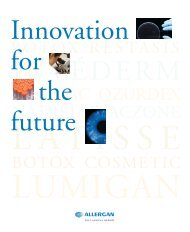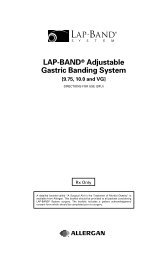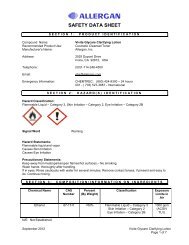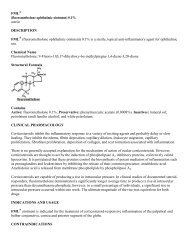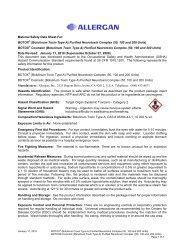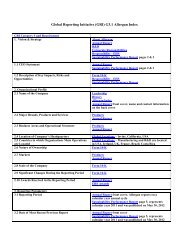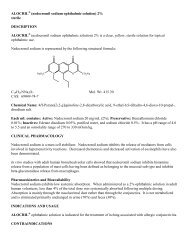LUMIGAN ® 0.01% and 0.03% - Allergan
LUMIGAN ® 0.01% and 0.03% - Allergan
LUMIGAN ® 0.01% and 0.03% - Allergan
Create successful ePaper yourself
Turn your PDF publications into a flip-book with our unique Google optimized e-Paper software.
HIGHLIGHTS OF PRESCRIBING INFORMATION<br />
These highlights do not include all the information needed to<br />
use <strong>LUMIGAN</strong> <strong>®</strong> <strong>0.01%</strong> <strong>and</strong> <strong>0.03%</strong> (bimatoprost ophthalmic<br />
solution) safely <strong>and</strong> effectively. See full prescribing<br />
information for <strong>LUMIGAN</strong> <strong>®</strong> .<br />
<strong>LUMIGAN</strong> <strong>®</strong> <strong>0.01%</strong> <strong>and</strong> <strong>0.03%</strong> (bimatoprost ophthalmic<br />
solution)<br />
Initial U.S. Approval: 2001<br />
______________ INDICATIONS AND USAGE<br />
_____________<br />
<strong>LUMIGAN</strong> <strong>®</strong> is a prostagl<strong>and</strong>in analog indicated for the<br />
reduction of elevated intraocular pressure in patients with open<br />
angle glaucoma or ocular hypertension. (1)<br />
_________ DOSAGE AND ADMINISTRATION<br />
___________<br />
One drop in the affected eye(s) once daily in the evening. (2)<br />
__________ DOSAGE FORMS AND STRENGTHS<br />
_________<br />
Solution containing 0.1 mg/mL bimatoprost (<strong>LUMIGAN</strong> <strong>®</strong><br />
<strong>0.01%</strong>) or containing 0.3 mg/mL bimatoprost (<strong>LUMIGAN</strong> <strong>®</strong><br />
<strong>0.03%</strong>). (3)<br />
_______________ CONTRAINDICATIONS<br />
_______________<br />
None (4)<br />
____________ WARNINGS AND PRECAUTIONS<br />
_________<br />
Pigmentation.<br />
Pigmentation of the iris, periorbital tissue (eyelid) <strong>and</strong><br />
eyelashes can occur. Iris pigmentation is likely to be<br />
permanent. (5.1)<br />
Eyelash Changes.<br />
Gradual change to eyelashes including increased length,<br />
thickness <strong>and</strong> number of lashes. Usually reversible. (5.2)<br />
______________ ________________<br />
ADVERSE REACTIONS<br />
Most common adverse reaction (range 25%-45%) is conjunctival<br />
hyperemia. (6.1)<br />
To report SUSPECTED ADVERSE REACTIONS, contact<br />
<strong>Allergan</strong> at 1-800-433-8871 or FDA at 1-800-FDA-1088 or<br />
www.fda.gov/medwatch.<br />
________ USE IN SPECIFIC POPULATIONS<br />
________<br />
Use in pediatric patients below the age of 16 years is not<br />
recommended because of potential safety concerns related to<br />
increased pigmentation following long-term chronic use. (8.4)<br />
See 17 for PATIENT COUNSELING INFORMATION<br />
Revised: 03/2012<br />
FULL PRESCRIBING INFORMATION: CONTENTS*<br />
1 INDICATIONS AND USAGE<br />
2 DOSAGE AND ADMINISTRATION<br />
3 DOSAGE FORMS AND STRENGTHS<br />
4 CONTRAINDICATIONS<br />
5 WARNINGS AND PRECAUTIONS<br />
5.1 Pigmentation<br />
5.2 Eyelash Changes<br />
5.3 Intraocular Inflammation<br />
5.4 Macular Edema<br />
5.5 Angle-closure, Inflammatory, or Neovascular<br />
Glaucoma<br />
5.6 Bacterial Keratitis<br />
5.7 Use with Contact Lenses<br />
6 ADVERSE REACTIONS<br />
6.1 Clinical Studies Experience<br />
6.2 Postmarketing Experience<br />
8 USE IN SPECIFIC POPULATIONS<br />
8.1 Pregnancy<br />
8.3 Nursing Mothers<br />
8.4 Pediatric Use<br />
8.5 Geriatric Use<br />
8.6 Hepatic Impairment<br />
10 OVERDOSAGE<br />
11 DESCRIPTION<br />
12 CLINICAL PHARMACOLOGY<br />
12.1 Mechanism of Action<br />
12.3 Pharmacokinetics<br />
13 NONCLINICAL TOXICOLOGY<br />
13.1 Carcinogenesis, Mutagenesis, Impairment of Fertility<br />
14 CLINICAL STUDIES<br />
16 HOW SUPPLIED/STORAGE AND HANDLING<br />
17 PATIENT COUNSELING INFORMATION<br />
17.1 Potential for Pigmentation<br />
17.2 Potential for Eyelash Changes<br />
17.3 H<strong>and</strong>ling the Container<br />
17.4 When to Seek Physician Advice<br />
17.5 Use with Contact Lenses<br />
17.6 Use with Other Ophthalmic Drugs<br />
* Sections or subsections omitted from the full prescribing<br />
information are not listed
FULL PRESCRIBING INFORMATION<br />
1 INDICATIONS AND USAGE<br />
<strong>LUMIGAN</strong> <strong>®</strong> <strong>0.01%</strong> <strong>and</strong> <strong>0.03%</strong> (bimatoprost ophthalmic solution) is indicated for the reduction of elevated<br />
intraocular pressure in patients with open angle glaucoma or ocular hypertension.<br />
2 DOSAGE AND ADMINISTRATION<br />
The recommended dosage is one drop in the affected eye(s) once daily in the evening. <strong>LUMIGAN</strong> <strong>®</strong> <strong>0.01%</strong> <strong>and</strong><br />
<strong>0.03%</strong> (bimatoprost ophthalmic solution) should not be administered more than once daily since it has been<br />
shown that more frequent administration of prostagl<strong>and</strong>in analogs may decrease the intraocular pressure<br />
lowering effect.<br />
Reduction of the intraocular pressure starts approximately 4 hours after the first administration with maximum<br />
effect reached within approximately 8 to 12 hours.<br />
<strong>LUMIGAN</strong> <strong>®</strong> may be used concomitantly with other topical ophthalmic drug products to lower intraocular<br />
pressure. If more than one topical ophthalmic drug is being used, the drugs should be administered at least five<br />
(5) minutes apart.<br />
3 DOSAGE FORMS AND STRENGTHS<br />
Ophthalmic solution containing bimatoprost 0.1 mg/mL (<strong>LUMIGAN</strong> <strong>®</strong> <strong>0.01%</strong>) or containing bimatoprost 0.3<br />
mg/mL (<strong>LUMIGAN</strong> <strong>®</strong> <strong>0.03%</strong>).<br />
4 CONTRAINDICATIONS<br />
None<br />
5 WARNINGS AND PRECAUTIONS<br />
5.1 Pigmentation<br />
Bimatoprost ophthalmic solution has been reported to cause changes to pigmented tissues. The most frequently<br />
reported changes have been increased pigmentation of the iris, periorbital tissue (eyelid) <strong>and</strong> eyelashes.<br />
Pigmentation is expected to increase as long as bimatoprost is administered. The pigmentation change is due to<br />
increased melanin content in the melanocytes rather than to an increase in the number of melanocytes. After<br />
discontinuation of bimatoprost, pigmentation of the iris is likely to be permanent, while pigmentation of the<br />
periorbital tissue <strong>and</strong> eyelash changes have been reported to be reversible in some patients. Patients who receive<br />
treatment should be informed of the possibility of increased pigmentation. The long term effects of<br />
increased pigmentation are not known.<br />
Iris color change may not be noticeable for several months to years. Typically, the brown pigmentation around<br />
the pupil spreads concentrically towards the periphery of the iris <strong>and</strong> the entire iris or parts of the iris become<br />
more brownish. Neither nevi nor freckles of the iris appear to be affected by treatment. While treatment with<br />
<strong>LUMIGAN</strong> <strong>®</strong> <strong>0.01%</strong> <strong>and</strong> <strong>0.03%</strong> (bimatoprost ophthalmic solution) can be continued in patients who develop<br />
noticeably increased iris pigmentation, these patients should be examined regularly [see Patient Counseling<br />
Information (17.1)].<br />
5.2 Eyelash Changes<br />
<strong>LUMIGAN</strong> <strong>®</strong> <strong>0.01%</strong> <strong>and</strong> <strong>0.03%</strong> may gradually change eyelashes <strong>and</strong> vellus hair in the treated eye. These<br />
changes include increased length, thickness, <strong>and</strong> number of lashes. Eyelash changes are usually reversible upon<br />
discontinuation of treatment.<br />
5.3 Intraocular Inflammation
<strong>LUMIGAN</strong> <strong>®</strong> <strong>0.01%</strong> <strong>and</strong> <strong>0.03%</strong> should be used with caution in patients with active intraocular inflammation<br />
(e.g., uveitis) because the inflammation may be exacerbated.<br />
5.4 Macular Edema<br />
Macular edema, including cystoid macular edema, has been reported during treatment with bimatoprost<br />
ophthalmic solution. <strong>LUMIGAN</strong> <strong>®</strong> <strong>0.01%</strong> <strong>and</strong> <strong>0.03%</strong> should be used with caution in aphakic patients, in<br />
pseudophakic patients with a torn posterior lens capsule, or in patients with known risk factors for macular<br />
edema.<br />
5.5 Angle-closure, Inflammatory, or Neovascular Glaucoma<br />
<strong>LUMIGAN</strong> <strong>®</strong> <strong>0.01%</strong> <strong>and</strong> <strong>0.03%</strong> has not been evaluated for the treatment of angle-closure, inflammatory or<br />
neovascular glaucoma.<br />
5.6 Bacterial Keratitis<br />
There have been reports of bacterial keratitis associated with the use of multiple-dose containers of topical<br />
ophthalmic products. These containers had been inadvertently contaminated by patients who, in most cases, had<br />
a concurrent corneal disease or a disruption of the ocular epithelial surface [see Patient Counseling Information<br />
(17.3)].<br />
5.7 Use with Contact Lenses<br />
Contact lenses should be removed prior to instillation of <strong>LUMIGAN</strong> <strong>®</strong> <strong>0.01%</strong> <strong>and</strong> <strong>0.03%</strong> <strong>and</strong> may be reinserted<br />
15 minutes following its administration.<br />
6 ADVERSE REACTIONS<br />
6.1 Clinical Studies Experience<br />
Because clinical studies are conducted under widely varying conditions, adverse reaction rates observed in the<br />
clinical studies of a drug cannot be directly compared to rates in the clinical studies of another drug <strong>and</strong> may not<br />
reflect the rates observed in practice.<br />
In clinical studies with bimatoprost ophthalmic solutions (<strong>0.01%</strong> or <strong>0.03%</strong>) the most common adverse reaction<br />
was conjunctival hyperemia (range 25%–45%). Approximately 0.5% to 3% of patients discontinued therapy<br />
due to conjunctival hyperemia with <strong>0.01%</strong> or <strong>0.03%</strong> bimatoprost ophthalmic solutions. Other common reactions<br />
(>10%) included growth of eyelashes, <strong>and</strong> ocular pruritus.<br />
Additional ocular adverse reactions (reported in 1 to 10% of patients) with bimatoprost ophthalmic solutions<br />
included ocular dryness, visual disturbance, ocular burning, foreign body sensation, eye pain, pigmentation of<br />
the periocular skin, blepharitis, cataract, superficial punctate keratitis, periorbital erythema, ocular irritation,<br />
eyelash darkening, eye discharge, tearing, photophobia, allergic conjunctivitis, asthenopia, increases in iris<br />
pigmentation, conjunctival edema, conjunctival hemorrhage, <strong>and</strong> abnormal hair growth. Intraocular<br />
inflammation, reported as iritis, was reported in less than 1% of patients.<br />
Systemic adverse reactions reported in approximately 10% of patients with bimatoprost ophthalmic solutions<br />
were infections (primarily colds <strong>and</strong> upper respiratory tract infections). Other systemic adverse reactions<br />
(reported in 1 to 5% of patients) included headaches, abnormal liver function tests, <strong>and</strong> asthenia.<br />
6.2 Postmarketing Experience<br />
The following reactions have been identified during postmarketing use of <strong>LUMIGAN</strong> <strong>®</strong> <strong>0.01%</strong> <strong>and</strong> <strong>0.03%</strong> in clinical<br />
practice. Because they are reported voluntarily from a population of unknown size, estimates of frequency cannot be<br />
made. The reactions, which have been chosen for inclusion due to either their seriousness, frequency of reporting,
possible causal connection to <strong>LUMIGAN</strong> <strong>®</strong> , or a combination of these factors, include: dizziness, eyelid edema,<br />
hypertension, nausea, <strong>and</strong> periorbital <strong>and</strong> lid changes associated with a deepening of the eyelid sulcus.<br />
8 USE IN SPECIFIC POPULATIONS<br />
8.1 Pregnancy<br />
Pregnancy Category C<br />
Teratogenic effects: In embryo/fetal developmental studies in pregnant mice <strong>and</strong> rats, abortion was observed at<br />
oral doses of bimatoprost which achieved at least 33 or 97 times, respectively, the maximum intended human<br />
exposure based on blood AUC levels.<br />
At doses at least 41 times the maximum intended human exposure based on blood AUC levels, the gestation<br />
length was reduced in the dams, the incidence of dead fetuses, late resorptions, peri- <strong>and</strong> postnatal pup mortality<br />
was increased, <strong>and</strong> pup body weights were reduced.<br />
There are no adequate <strong>and</strong> well-controlled studies of <strong>LUMIGAN</strong> <strong>®</strong> <strong>0.01%</strong> <strong>and</strong> <strong>0.03%</strong> (bimatoprost<br />
ophthalmic solution) administration in pregnant women. Because animal reproductive studies are not<br />
always predictive of human response <strong>LUMIGAN</strong> <strong>®</strong> should be administered during pregnancy only if the<br />
potential benefit justifies the potential risk to the fetus.<br />
8.3 Nursing Mothers<br />
It is not known whether <strong>LUMIGAN</strong> <strong>®</strong> <strong>0.01%</strong> <strong>and</strong> <strong>0.03%</strong> is excreted in human milk, although in animal studies,<br />
bimatoprost has been shown to be excreted in breast milk. Because many drugs are excreted in human milk,<br />
caution should be exercised when <strong>LUMIGAN</strong> <strong>®</strong> is administered to a nursing woman.<br />
8.4 Pediatric Use<br />
Use in pediatric patients below the age of 16 years is not recommended because of potential safety concerns<br />
related to increased pigmentation following long-term chronic use.<br />
8.5 Geriatric Use<br />
No overall clinical differences in safety or effectiveness have been observed between elderly <strong>and</strong> other adult<br />
patients.<br />
8.6 Hepatic Impairment<br />
In patients with a history of liver disease or abnormal ALT, AST <strong>and</strong>/or bilirubin at baseline, bimatoprost<br />
<strong>0.03%</strong> had no adverse effect on liver function over 48 months.<br />
10 OVERDOSAGE<br />
No information is available on overdosage in humans. If overdose with <strong>LUMIGAN</strong> <strong>®</strong> <strong>0.01%</strong> <strong>and</strong> <strong>0.03%</strong><br />
(bimatoprost ophthalmic solution) occurs, treatment should be symptomatic.<br />
In oral (by gavage) mouse <strong>and</strong> rat studies, doses up to 100 mg/kg/day did not produce any toxicity. This<br />
dose expressed as mg/m 2 is at least 70 times higher than the accidental dose of one bottle of <strong>LUMIGAN</strong> <strong>®</strong><br />
<strong>0.03%</strong> for a 10 kg child.<br />
11 DESCRIPTION<br />
<strong>LUMIGAN</strong> <strong>®</strong> <strong>0.01%</strong> <strong>and</strong> <strong>0.03%</strong> (bimatoprost ophthalmic solution) is a synthetic prostamide analog with ocular<br />
hypotensive activity. Its chemical name is (Z)-7-[(1R,2R,3R,5S)-3,5-Dihydroxy-2-[(1E,3S)-3-hydroxy-5-phenyl-<br />
1-pentenyl]cyclopentyl]-5-N-ethylheptenamide, <strong>and</strong> its molecular weight is 415.58. Its molecular formula is<br />
C 25 H 37 NO 4 . Its chemical structure is:
Bimatoprost is a powder, which is very soluble in ethyl alcohol <strong>and</strong> methyl alcohol <strong>and</strong> slightly soluble in<br />
water. <strong>LUMIGAN</strong> <strong>®</strong> <strong>0.01%</strong> <strong>and</strong> <strong>0.03%</strong> is a clear, isotonic, colorless, sterile ophthalmic solution with an<br />
osmolality of approximately 290 mOsmol/kg.<br />
<strong>LUMIGAN</strong> <strong>®</strong> <strong>0.01%</strong> contains Active: bimatoprost 0.1 mg/mL; Preservative: benzalkonium chloride 0.2<br />
mg/mL; Inactives: sodium chloride; sodium phosphate, dibasic; citric acid; <strong>and</strong> purified water. Sodium<br />
hydroxide <strong>and</strong>/or hydrochloric acid may be added to adjust pH. The pH during its shelf life ranges from 6.8-7.8.<br />
<strong>LUMIGAN</strong> <strong>®</strong> <strong>0.03%</strong> contains Active: bimatoprost 0.3 mg/mL; Preservative: benzalkonium chloride 0.05<br />
mg/mL; Inactives: sodium chloride; sodium phosphate, dibasic; citric acid; <strong>and</strong> purified water. Sodium<br />
hydroxide <strong>and</strong>/or hydrochloric acid may be added to adjust pH. The pH during its shelf life ranges from 6.8-7.8.<br />
12 CLINICAL PHARMACOLOGY<br />
12.1 Mechanism of Action<br />
Bimatoprost, a prostagl<strong>and</strong>in analog, is a synthetic structural analog of prostagl<strong>and</strong>in with ocular hypotensive<br />
activity. It selectively mimics the effects of naturally occurring substances, prostamides. Bimatoprost is<br />
believed to lower intraocular pressure (IOP) in humans by increasing outflow of aqueous humor through both<br />
the trabecular meshwork <strong>and</strong> uveoscleral routes. Elevated IOP presents a major risk factor for glaucomatous<br />
field loss. The higher the level of IOP, the greater the likelihood of optic nerve damage <strong>and</strong> visual field loss.<br />
12.3 Pharmacokinetics<br />
Absorption: After one drop of bimatoprost ophthalmic solution <strong>0.03%</strong> was administered once daily to both eyes<br />
of 15 healthy subjects for two weeks, blood concentrations peaked within 10 minutes after dosing <strong>and</strong> were<br />
below the lower limit of detection (0.025 ng/mL) in most subjects within 1.5 hours after dosing. Mean C max <strong>and</strong><br />
AUC 0-24hr values were similar on days 7 <strong>and</strong> 14 at approximately 0.08 ng/mL <strong>and</strong> 0.09 ng•hr/mL,<br />
respectively, indicating that steady state was reached during the first week of ocular dosing. There was no<br />
significant systemic drug accumulation over time.<br />
Distribution: Bimatoprost is moderately distributed into body tissues with a steady-state volume of distribution<br />
of 0.67 L/kg. In human blood, bimatoprost resides mainly in the plasma. Approximately 12% of bimatoprost<br />
remains unbound in human plasma.<br />
Metabolism: Bimatoprost is the major circulating species in the blood once it reaches the systemic circulation<br />
following ocular dosing. Bimatoprost then undergoes oxidation, N-deethylation <strong>and</strong> glucuronidation to form a<br />
diverse variety of metabolites.<br />
Elimination: Following an intravenous dose of radiolabeled bimatoprost (3.12 mcg/kg) to six healthy subjects,<br />
the maximum blood concentration of unchanged drug was 12.2 ng/mL <strong>and</strong> decreased rapidly with an<br />
elimination half-life of approximately 45 minutes. The total blood clearance of bimatoprost was 1.5 L/hr/kg. Up<br />
to 67% of the administered dose was excreted in the urine while 25% of the dose was recovered in the feces.
13 NONCLINICAL TOXICOLOGY<br />
13.1 Carcinogenesis, Mutagenesis, Impairment of Fertility<br />
Bimatoprost was not carcinogenic in either mice or rats when administered by oral gavage at doses of up to 2<br />
mg/kg/day <strong>and</strong> 1 mg/kg/day respectively (at least 192 <strong>and</strong> 291 times the recommended human exposure based<br />
on blood AUC levels respectively) for 104 weeks.<br />
Bimatoprost was not mutagenic or clastogenic in the Ames test, in the mouse lymphoma test, or in the in vivo<br />
mouse micronucleus tests.<br />
Bimatoprost did not impair fertility in male or female rats up to doses of 0.6 mg/kg/day (at least 103 times the<br />
recommended human exposure based on blood AUC levels).<br />
14 CLINICAL STUDIES<br />
In clinical studies of patients with open angle glaucoma or ocular hypertension with a mean baseline IOP of 26<br />
mmHg, the IOP-lowering effect of <strong>LUMIGAN</strong> <strong>®</strong> <strong>0.03%</strong> (bimatoprost ophthalmic solution) once daily (in the<br />
evening) was 7-8 mmHg.<br />
In a 3 month clinical study of patients with open angle glaucoma or ocular hypertension with an average<br />
baseline IOP of 23.5 mmHg, the IOP-lowering effect of <strong>LUMIGAN</strong> <strong>®</strong> <strong>0.01%</strong> once daily (in the evening) was up<br />
to 7.5 mmHg <strong>and</strong> was approximately 0.5 mmHg less effective than <strong>LUMIGAN</strong> <strong>®</strong> <strong>0.03%</strong>. In this same study,<br />
<strong>LUMIGAN</strong> <strong>®</strong> <strong>0.01%</strong> also had a similar overall safety profile compared with <strong>LUMIGAN</strong> <strong>®</strong> <strong>0.03%</strong>. After<br />
12 months of treatment, discontinuations were 8.1% for <strong>LUMIGAN</strong> <strong>®</strong> <strong>0.01%</strong> <strong>and</strong> 13.4% for <strong>LUMIGAN</strong> <strong>®</strong><br />
<strong>0.03%</strong>.<br />
16 HOW SUPPLIED/STORAGE AND HANDLING<br />
<strong>LUMIGAN</strong> <strong>®</strong> (bimatoprost ophthalmic solution) <strong>0.01%</strong> is supplied sterile in opaque white low density<br />
polyethylene ophthalmic dispenser bottles <strong>and</strong> tips with turquoise polystyrene caps in the following sizes:<br />
2.5 mL fill in a 5 mL container - NDC 0023-3205-03<br />
5 mL fill in a 10 mL container - NDC 0023-3205-05<br />
7.5 mL fill in a 10 mL container - NDC 0023-3205-08<br />
<strong>LUMIGAN</strong> <strong>®</strong> (bimatoprost ophthalmic solution) <strong>0.03%</strong> is supplied sterile in opaque white low density<br />
polyethylene ophthalmic dispenser bottles <strong>and</strong> tips with turquoise polystyrene caps in the following sizes:<br />
2.5 mL fill in 5 mL container - NDC 0023-9187-03<br />
5 mL fill in 10 mL container - NDC 0023-9187-05<br />
7.5 mL fill in 10 mL container - NDC 0023-9187-07<br />
Storage: <strong>LUMIGAN</strong> <strong>®</strong> <strong>0.01%</strong> <strong>and</strong> <strong>0.03%</strong> should be stored at 2° to 25°C (36° to 77°F).<br />
17 PATIENT COUNSELING INFORMATION<br />
17.1 Potential for Pigmentation<br />
Patients should be advised about the potential for increased brown pigmentation of the iris, which may be<br />
permanent. Patients should also be informed about the possibility of eyelid skin darkening, which may be<br />
reversible after discontinuation of <strong>LUMIGAN</strong> <strong>®</strong> <strong>0.01%</strong> <strong>and</strong> <strong>0.03%</strong> (bimatoprost ophthalmic solution).<br />
17.2 Potential for Eyelash Changes<br />
Patients should also be informed of the possibility of eyelash <strong>and</strong> vellus hair changes in the treated eye during<br />
treatment with <strong>LUMIGAN</strong> <strong>®</strong> <strong>0.01%</strong> <strong>and</strong> <strong>0.03%</strong>. These changes may result in a disparity between eyes in length,
thickness, pigmentation, number of eyelashes or vellus hairs, <strong>and</strong>/or direction of eyelash growth. Eyelash<br />
changes are usually reversible upon discontinuation of treatment.<br />
17.3 H<strong>and</strong>ling the Container<br />
Patients should be instructed to avoid allowing the tip of the dispensing container to contact the eye,<br />
surrounding structures, fingers, or any other surface in order to avoid contamination of the solution by common<br />
bacteria known to cause ocular infections. Serious damage to the eye <strong>and</strong> subsequent loss of vision may result<br />
from using contaminated solutions.<br />
17.4 When to Seek Physician Advice<br />
Patients should also be advised that if they develop an intercurrent ocular condition (e.g., trauma or infection),<br />
have ocular surgery, or develop any ocular reactions, particularly conjunctivitis <strong>and</strong> eyelid reactions, they<br />
should immediately seek their physician’s advice concerning the continued use of <strong>LUMIGAN</strong> <strong>®</strong> <strong>0.01%</strong> <strong>and</strong><br />
<strong>0.03%</strong>.<br />
17.5 Use with Contact Lenses<br />
Patients should be advised that <strong>LUMIGAN</strong> <strong>®</strong> <strong>0.01%</strong> <strong>and</strong> <strong>0.03%</strong> contains benzalkonium chloride, which may be<br />
absorbed by soft contact lenses. Contact lenses should be removed prior to instillation of <strong>LUMIGAN</strong> <strong>®</strong> <strong>and</strong> may<br />
be reinserted 15 minutes following its administration.<br />
17.6 Use with Other Ophthalmic Drugs<br />
Patients should be advised that if more than one topical ophthalmic drug is being used, the drugs should be<br />
administered at least five (5) minutes between applications.<br />
© 2012 <strong>Allergan</strong>, Inc.<br />
Irvine, CA 92612<br />
<strong>®</strong> marks owned by <strong>Allergan</strong>, Inc.<br />
Patented. See: www.allergan.com/products/patent_notices<br />
Made in the U.S.A.<br />
71807US13





